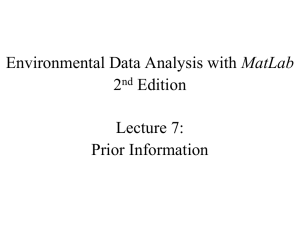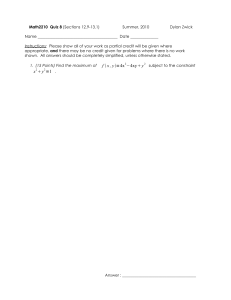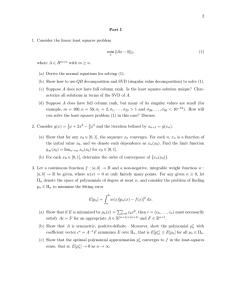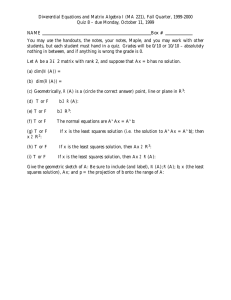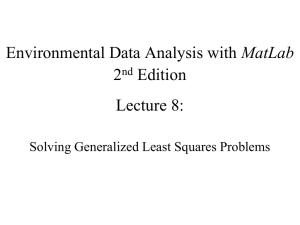MatLab Lecture 7: Prior Information
advertisement
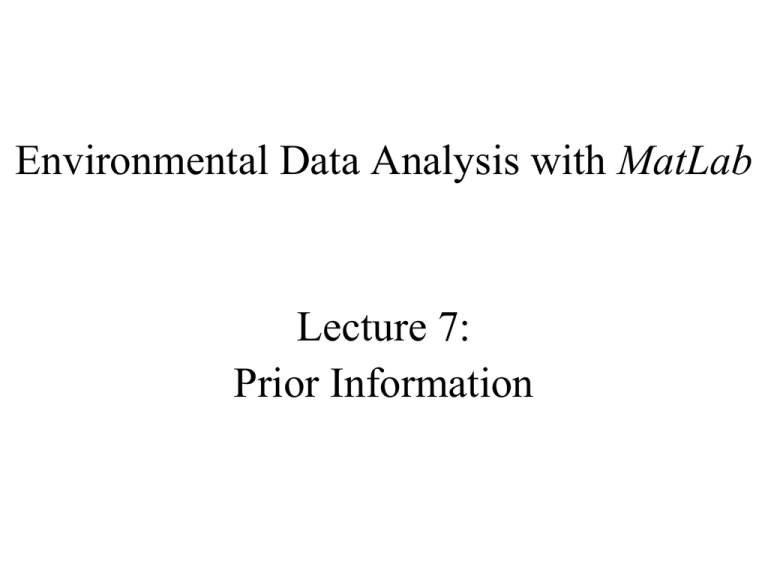
Environmental Data Analysis with MatLab Lecture 7: Prior Information SYLLABUS Lecture 01 Lecture 02 Lecture 03 Lecture 04 Lecture 05 Lecture 06 Lecture 07 Lecture 08 Lecture 09 Lecture 10 Lecture 11 Lecture 12 Lecture 13 Lecture 14 Lecture 15 Lecture 16 Lecture 17 Lecture 18 Lecture 19 Lecture 20 Lecture 21 Lecture 22 Lecture 23 Lecture 24 Using MatLab Looking At Data Probability and Measurement Error Multivariate Distributions Linear Models The Principle of Least Squares Prior Information Solving Generalized Least Squares Problems Fourier Series Complex Fourier Series Lessons Learned from the Fourier Transform Power Spectra Filter Theory Applications of Filters Factor Analysis Orthogonal functions Covariance and Autocorrelation Cross-correlation Smoothing, Correlation and Spectra Coherence; Tapering and Spectral Analysis Interpolation Hypothesis testing Hypothesis Testing continued; F-Tests Confidence Limits of Spectra, Bootstraps purpose of the lecture understand the advantages and limitations of supplementing observations with prior information when least-squares fails fitting of straight line cases were there’s more than one solution d d d1 d* x1 x E exactly 0 for any lines passing through point one point x* x E minimum for all lines passing through point x* T [G G] when determinant of is zero that is, D=0 [GTG]-1 is singular N=1 case d d1 x1 x E exactly 0 for any lines passing through point one point xi =x* case d d* x* x E minimum for any lines passing through point x* least-squares fails when the data do not uniquely determine the solution if [GTG]-1 is singular least squares solution doesn’t exist if [GTG]-1 is almost singular least squares is useless because it has high variance very large guiding principle for avoiding failure add information to the problem that guarantees that matrices like [GTG] are never singular such information is called prior information examples of prior information soil has density will be around 1500 kg/m3 give or take 500 or so chemical components sum to 100% pollutant transport is subject to the diffusion equation water in rivers always flows downhill prior information things we know about the solution based on our knowledge and experience but not directly based on data simplest prior information m is near some value, m m≈m with covariance Cmp use Normal p.d.f. to prepresent prior information prior information pp(m) 0 0 20 40 m2 10 example: m1 = 10 ± 5 m2 = 20 ± 5 40 m1 m1 and m2 uncorrelated Normal p.d.f. defines an “error in prior information” individual errors weighted by their certainty linear prior information with covariance Ch example relevant to chemical constituents H h use Normal p.d.f. to represent prior information Normal p.d.f. defines an “error in prior information” individual errors weighted by their certainty since m ∝ h pp(m) ∝ pp(h) so we can view this formula as a p.d.f. for the model parameters, m pp(m) ∝ (Technically, the p.d.f.’s are only proportional when the Jacobian Determinant is constant, which it is in this case). now suppose that we observe some data: d = dobs with covariance Cd use Normal p.d.f. to represent the observations d with covariance Cd now assume that the mean of the data is predicted by the model: d = Gm represent the observations with a Normal p.d.f. p(d) = observations weighted by their certainty mean of data predicted by the model Normal p.d.f. defines an “error in data” weighted leastsquares error p(d) = think of p(d) as a conditional p.d.f. probability that a particular set of data values will be observed given a particular choice of model parameters example: p(d|m) 0 0 20 one datum 40 m2 2 model parameters 10 model d1=m1 –m2 40 m1 one observation d1obs = 0 ± 3 now use Bayes theorem to update the prior information with the observations ignore for a moment Bayes Theorem in words so the updated p.d.f. for the model parameters is: data part prior information part this p.d.f. defines a “total error” weighted least squares error in the data with weighted error in the prior information Generalized Principle of Least Squares the best mest is the one that minimizes the total error with respect to m which is the same one as the one that maximized p(m|d) with respect to m continuing the example … A) pp(m) 0 0 20 40 m2 B) p(d|m) 0 0 20 40 m2 C) p(m|d) 0 0 15 40 m2 10 10 13 40 40 m1 40 m1 m1 best estimate of the model parameters generalized least squares find the m that minimizes generalized least squares solution pattern same as ordinary least squares but with more complicated matrices
